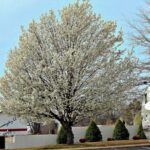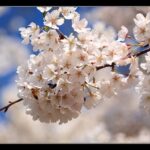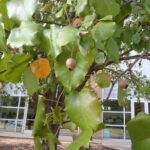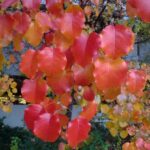On the Lookout for Non-Native Invasive Plant Species: Callery Pear
go.ncsu.edu/readext?1105385
en Español / em Português
El inglés es el idioma de control de esta página. En la medida en que haya algún conflicto entre la traducción al inglés y la traducción, el inglés prevalece.
Al hacer clic en el enlace de traducción se activa un servicio de traducción gratuito para convertir la página al español. Al igual que con cualquier traducción por Internet, la conversión no es sensible al contexto y puede que no traduzca el texto en su significado original. NC State Extension no garantiza la exactitud del texto traducido. Por favor, tenga en cuenta que algunas aplicaciones y/o servicios pueden no funcionar como se espera cuando se traducen.
Português
Inglês é o idioma de controle desta página. Na medida que haja algum conflito entre o texto original em Inglês e a tradução, o Inglês prevalece.
Ao clicar no link de tradução, um serviço gratuito de tradução será ativado para converter a página para o Português. Como em qualquer tradução pela internet, a conversão não é sensivel ao contexto e pode não ocorrer a tradução para o significado orginal. O serviço de Extensão da Carolina do Norte (NC State Extension) não garante a exatidão do texto traduzido. Por favor, observe que algumas funções ou serviços podem não funcionar como esperado após a tradução.
English
English is the controlling language of this page. To the extent there is any conflict between the English text and the translation, English controls.
Clicking on the translation link activates a free translation service to convert the page to Spanish. As with any Internet translation, the conversion is not context-sensitive and may not translate the text to its original meaning. NC State Extension does not guarantee the accuracy of the translated text. Please note that some applications and/or services may not function as expected when translated.
Collapse ▲There are a wide variety of non-native invasive plant species that have taken hold in Madison County. These plants cause harm to the environment, as well as potential harm to human, animal, and plant health in the preexisting environment. Some of these damages can be caused by overtaking beneficial native plants in the ecosystem, act as vectors for diseases and other invasive species, such as invasive insects, and are unhealthy or potentially toxic to native animals. In this series, we will discuss identification and control of these prevalent invasive plants.
Identifying Callery Pear
Callery Pears (scientific name Pyrus calleryana), better known as their cultivated ornamental variety called the Bradford Pear, is a deciduous broadleaf tree in the rose family. Callery pears originated in Asia, and have become invasive species throughout North Carolina and the rest of the southeastern United States. It is considered a small to medium sized tree, growing from about 30 to 50 feet tall with the branches spreading out to about 20 to 35 feet wide, with smooth bark in a light brown to light reddish brown color, which can sometimes also appear a light gray. As the trees age, the smooth bark can become rougher, with furrows, ridges, and lenticels, with several of these features starting to appear like cracks or split areas through the bark. The leaves of this tree are about 1 to 3 inches in length and about 1 to 3 inches wide, and appear glossy and dark green in an oval-like shape, with an almost leathery texture to the touch, with paler green undersides to the leaves. The leaves can change to a variety of fall colors, ranging from yellow to orange to red to even almost purple colors. Callery Pears are known for their flowers, as they bloom early in the spring with small white or cream colored flowers less than an inch in size, and emit a foul stench from the blooms to attract the insects that are its common pollinators. These flowers bloom in clusters on the branches, forming groups that can cover the entire tree in blooming white flowers with a malodorous smell.
The branches of Callery Pears grow at steep upright angles, and are known for being weak and breaking with age, or in heavy winds and ice, causing potential damages in areas where these trees are planted. The twigs and branches of this invasive tree may also develop thorns at the tip, making it a potentially hazardous inclusion in populated areas, especially when dealing with cleanup of broken limbs. Callery Pears also produce a fruit in a yellowish-green or brown color, and are round in shape and about 1 inch in diameter. The only viable use for fruits of the Callery Pear is to be food for birds, as they cannot be ornamental or used for any other practical use. These trees can tolerate a relatively wide variety of environmental conditions, attributing to its invasiveness. It can tolerate both full sun and partial shade areas, as well as acidic, neutral, and basic soils, a variety of soil textures, including clay, sandy, and silty. When Callery Pears cross-pollinate with other trees, they create more callery pears, the base, non-cultivar invasive species, allowing it to spread into undesirable areas even quicker.
- Fruit Martin LaBar CC BY-NC 2.0 Image retrieved from NC Extension Gardener Plant Toolbox
- Whole tree Country Boy 1949 CC-BY-SA 2.0 Image retrieved from NC Extension Gardener Plant Toolbox
- Flowers Gary Craig CC BY-NC-ND 2.0 Image retrieved from NC Extension Gardener Plant Toolbox
- OLYMPUS DIGITAL CAMERA ‘Bradford’ Fruit and Leaves Jim Robbins CC BY-NC-ND 4.0 Image retrieved from NC Extension Gardener Plant Toolbox
- OLYMPUS DIGITAL CAMERA’Bradford’ Fall Color Leaf and Fruit Jim Robbins CC BY-NC-ND 4.0 Image retrieved from NC Extension Gardener Plant Toolbox
How It Spreads
The callery pear species was first introduced in the United States in the early 1900s, originally brought in to help introduce resistance to fire blight into the commercial pear industry. The common cultivar known as the “Bradford Pear”, which we most often encounter, was developed in the 1950s and created to be an ornamental tree. Callery pears are often planted in highly urbanized areas, such as residential and commercial developments to add fast growing greenery into spaces where other trees or ornamental plants might be more difficult to establish. They can form into dense thickets of thorns if allowed to grow unchecked, and can overtake native plant populations, especially those that cannot tolerate shaded areas. It produces many seeds that are spread by wildlife that eat the seeds and fruits, such as birds and small mammals, and many of those seeds germinate and grow quickly into weak, malodorous trees. These prolifically seeding trees are known to have few pests and diseases that harm them, also helping them outcompete other native species and causing more future forest damage as it breaks in heavy winds or under its own weight as it continues to grow.
Controlling Callery Pears
Just like any other invasive species, it will take patience and dedication to control the presence and spread of Callery Pears. Due to the fact that they can form such dense thickets, as well as being such prolific seeders and quickly growing, these invasive plants can be extremely hard to battle using only mechanical means of removal, such as cutting down trees. Because of this, chemical control is the most effective method of removing these invasive trees from the native ecosystem, and different growth patterns can potentially be combated using a few different methods of chemical control.
The first method of control is foliar, and it can be extremely useful in controlling those dense, thorny thickets that Callery Pears can form when multiple plants are growing together. There are a few different ways this can be done with a few different chemical combinations that can vary in effectiveness depending on the time of year when applied. The first option for foliar spray is a 4% triclopyr-ester (such as Garlon 4), meaning it is a selective herbicide active ingredient for woody plants in an oil based solution, mixed in a solution of 4% methylated seed oil (MSO). With this solution, it is important to soak most of the plant when spraying it, covering as much of the foliage as possible and the stems of the Callery Pear thickets. The ester based herbicides like this solution have a higher risk of herbicide drift, as the oil droplets are smaller and lighter than water-based herbicide droplets would be. These smaller droplets are easier for the wind to blow into undesirable areas, so be sure that the weather is conducive to the application to prevent unwanted damages. The other potential foliar spray solution is also a viable option, but they are most effective when sprayed on the Callery Pear thickets from mid-summer to the fall of the year. The more seasonal spray solution is a 3% triclopyr-amine (such as Garlon 3A), which means it is a selective herbicide active ingredient for woody plants in a salt-water based solution. These salt water based solutions are less likely to drift, as the droplets are heavier. The foliar spray application is also the most likely to cause unintentional damage to more desirable or native plants in the area, due to the potential issue of drift and the amount of spray solution needed for a successful application.
Large trees are best controlled using the cut-stump method of chemical control. To do this method, the Callery Pear must be cut within six inches of the ground, and the freshly cut stump must be immediately sprayed with a 50 percent triclopyr solution over the newly exposed stump surface, and down the sides of the stump. When using this method, the freshly cut stump must be sprayed within the first three minutes of being cut to be most effective due to turgor pressure within the trunk of the tree. Turgor pressure is caused by the pressure of water within the plant cells that allows the plant to keep its upright and rigid structure, as well as aiding in the flow of nutrients across the expanse of the plant, from the tips of the leaves to the ends of the roots underground. The lingering presence of this turgor pressure after the Callery Pear has been cut helps with plant absorption of the herbicide used to control this invasive species. This act of spraying after the trunk is cut must also be done quickly due to the fact that plants have the potential to scab over injuries to protect themselves. This can prevent absorption of the herbicide, and will prevent control of the Callery Pear’s root system. Without the control of this root system, it will direct energy to new sprouts to begin growing again. This cut-stump method is best used between summer and early fall, when the plants are redirecting their nutrient flow into their roots. This method is more forgiving of inclement weather than the foliar application method, and provides a more target application of herbicide to the desired plant.
The last method of chemical control for Callery Pears is known as basal treatment. This method is one of the easiest to use, but only works on trees with a trunk that is 6 inches in diameter or less, and does risk overspraying or volatilization if not used cautiously. Basal treatment has also shown success when used in areas where no other technique is easily available. This treatment should be conducted in later winter, or early spring or summer, and is conducted by applying an oil-based triclopyr herbicide (such as Garlon 4) in a 20% solution, or by using another triclopyr product in a 25% triclopyr to 75% mineral or agricultural oil solution, and spraying it on the Callery Pear from basal height (about 4 to 4.5 feet from the base) to about 12 to 16 inches from the ground.
When hoping to identify Callery Pears, it can be helpful to do so when they are in bloom in the spring and flag or mark them in a way that will allow you to find them again later. All of these aforementioned methods are effective ways to control Callery Pears, but even after treatment it is important to monitor and control basal sprouts or root suckers that may appear to ensure that this invasive species is eradicated after treatment.
If you have any other questions about identifying or controlling Callery Pears, please contact the Madison County Cooperative Extension Center at (828) 649-2411, or reach out to me directly at peyton_duckett@ncsu.edu.
Citations
Lambert, C. (2021, March 17). Callery Pear – Please Beware!. NC State Extension Forestry. https://forestry.ces.ncsu.edu/2021/03/callery-pear-please-beware/
North Carolina State University. (n.d.). Pyrus calleryana. North Carolina Extension Gardener Plant Toolbox. https://plants.ces.ncsu.edu/plants/pyrus-calleryana/
USDA. (n.d.). Callery Pear. USDA National Invasive Species Information Center. https://www.invasivespeciesinfo.gov/terrestrial/plants/callery-pear








